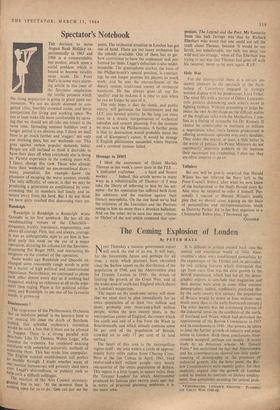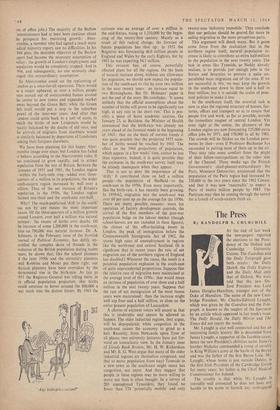The. Coming Explosion of London
By PETER HA LL
EXT Thursday a massive government report
will mark the end of an era. It will bury, for the foreseeable future and perhaps for all time, a myth which planners have cherished since the Barlow report on the distribution of the population in 1940, and the Abercrombie plan for Greater London in 1944: the dream of limiting the growth of the Great Wen, and of the wider area of south-east England which shares in London's magnetism.
The report on the south-east survey will show that we must start to plan immediately for an extra population of at least two million and more, probably over three-and-a-half million people, within the next twenty years, in the metropolitan corner of England; the corner which lies south and east of a line from the Wash to Bournemouth, and which already contains some 34 per cent of the population of Britain, crowded on to only 17 per cent of its land surface.
The heart of this area is the metropolitan region itself: the area within a circle of approxi- mately forty miles radius from Charing Cross. Here at the last Census in April, 1961, lived twelve-and-a-half million people—very nearly one-quarter of the entire population of Britain. This region is a little larger, in square miles, than the 'Greater London' for which Abercrombie produced his famous plan twenty years ago; but in terms of practical planning problems it is the same area.
It is difficult to project oneself back into the mental and emotional world of 1944. Aber- crombie's ideas were conditioned powerfully by the experiences of the Thirties and, in particular, by two striking features which distinguish that age from.ours. One was the slow growth in the British population, which had led all the demo- graphic experts to conclude that stagnation and then decline were sooh in store. (One eminent demographer, indeed, confidently predicted that by the early twenty-first century the population of Britain would be down to four million—not much more than in the early fourteenth century.) The'other feature was the continuing distress of the industrial areas on the coalfields of the north, of Scotland and Wales. which had provoked the appointment of the Barlow Commission in 1937 and its conclusions in 1940: that powers betaken to limit the further growth of industry and popu- lation in London. Both these conclusions Aber- crombie accepted, perhaps too readily. A recent study by an American scholar, Mr. Donald Foley,* has underlined the fact that Abercrombie and his contemporaries showed too little under- standing of demography or the processes of industrial growth. (On the latter point, the Bar- low Commissioners were equally guilty; for they implicitly argued that the growth of London could be limited by controls on factory employ- ment, thus completely. avoiding the central prob- * CONTROLLING LONDON'S GROWTH: PLANNING THE GREAT WEN 1940-60.
• !.m of office jobs.) The majority of the Barlow 'ommissioners had at least been cautious about he prospects for restricting growth: Aber- rombie, a member who had signed a much more adical minority report, saw no difficulties. In his 944 plan, the desirable objective of the Barlow eport had become the necessary assumption of tolicy : the growth of London's employment and topulation would be completely stopped. And in 944, and subsequently, no one seriously chal- znged this extraordinary assumption.
So Abercrombie could see the replanning of '..ondon as a once-for-all operation. There would to a major upheaval, as over a million people vere moved out of overcrowded homes around he centre to new towns and expanded market owns beyond the Green Belt; while the Green 3elt itself would put a stop to the suburban prawl of the inter-war years. And after that .ondon could settle back to a sort of stasis, in vhich the births of new Londoners would be 'xactly balanced by the deaths of old ones, and he arrivals of migrants from elsewhere would te similarly balanced by departures of Londoners eeking their fortunes elsewhere.
We have been planning for this happy Aber-
:rombie image ever since; but London has failed o behave according to the Abercrombie rules. It ias continued to grow rapidly, and to attract population from the rest of Britain. Between the 2enstises of 1951 and 1961, the London region –within the forty-mile ring—added over three- luarters of a million to its population; the wider outh-eastern region increased by well over a nillion. Thus of the net increase of Britain's Copulation in the 1950s, the London region :(aimed one-third and the south-east one-half. Why? The much-publicised 'drift to the south' vas not by any means the most important eason. Of the three-quarters of a million growth :round London, over half a million was natural ncrease: the excess of births over deaths. Of he increase of some 1,200,000 in the south-east, lose on 700,000 was natural increase. Dr. A. iolmans, in the February issue of the Scottish 'ournal of Political Economy, has deftly un- .avelled the complex skein of threads in the "volution of the British population during recent
rears; he shows that, like the school planners tf the later 1950s and the university planners intil Robbins and Moser put them right, our )hysical planners have been overtaken by the thenomenal rise in the birth-rate. As late as
'957 the Registrar-General was telling them, in tis official population projection, that births vould continue to hover around the 800,000 a ,:ear mark into the distant future. By 1963 the
'Au bi.shopric•s• vacant?'
estimate was an average of over a million in the mid-Sixties, rising to 1,310,000 by the begin- ning of the twenty-first century. Mainly as a result of this radical change, the forecast of future population has shot up: in 1952 the Registrar was forecasting 46.6 million people in England and Wales by the early Eighties, but by 1963 he was expecting 54.1 million.
This revision has, of course, powerfully affected plans for all the regions. On the basis of natural increase alone, without any allowance for migration, we should now expect the popula- tion of the south-east to rise by over two million in the next twenty years: an increase equal to two Birminghams. But Dr. Holmans' paper is not the end of the story. He concludes: 'It seems unlikely that the official assumptions about the number of births will prove to be significantly too high, at any rate in the short run.' This is pos- sibly a piece of Scots academic caution. On January 23, at Basildon, the Minister of Health announced that the birth-rate was already ten years ahead of the forecast made at the beginning of 1963: that on the basis of current trends it was quite possible that the projected 1975 num- ber of births would be reached by 1965. The effect on the 1964 projections of population, which appear in a few weeks' time, cannot be less than explosive. Indeed, it is quite possible that the estimates in the south-east survey itself may be already inadequate when they appear.
That is not to deny the importance of the 'drift.' It contributed close on half a million people—the population of Sheffield—to the south-east in the 1950s. Even more importantly, like the birth-rate, it has recently been growing. In 1959-62, migration into the south-east was over 60 per cent up on the average for the 1950s. There are many possible reasons: more lax operation of factory development controls, the arrival of the first members of the post-war population bulge on the labour market (though school-leavers are not included in these figures), the climax of the office-building boom in London, the peak of immigration before the Commonwealth Immigrants Act of 1962, the recent high rates of unemployment in regions like the north-east and central Scotland. (It is significant that in recent years the rate of net migration out of the northern region of England has doubled.) Whatever the cause, the result is a potential population explosion in the south-east of quite unprecedented proportions. Suppose that the relative rate of migration were maintained at the average level of the 1950s: that would mean an increase of population of over three and a half million in the next twenty years. Suppose that the rate of net immigration of the most recent years were maintained: then the increase might well top four and a half million, or close on the entire present population of Lancashire.
A chorus of eminent voices will assure us that this is intolerable and cannot be allowed to happen. The older industrial regions, they argue, will be depopulated; while congestion in the south-east causes the economy to grind to a halt. Recently, from Newcastle upon Tyne of all places, two university lecturers have put for- ward an iconoclastic view. In the January issue of Lloyds Bank Review, Mr. H. W. Richardson and Mr. E. G. West argue that many of the older industrial regions are themselves congested, and that to move population from (say) Tyneside to a new town in the south-east might mean less congestion, not more. And they suggest that people in these regions may be more willing to move out than is often thought. In a survey of 203 unemployed Tynesiders, they found no fewer than 174 'potentially mobile' and only twenty-nine 'definitely immobile.' They conclude that our policies should be geared far more to aiding migration to the more prosperous parts.
This argument will shock many. But it gains some force from the realisation that in the northern region itself, natural population in- crease is likely to contribute an extra half-million to the population in the next twenty years. The task in areas like Tyneside, as Neddy already realises, is to provide just enough jobs in the Sixties and Seventies to prevent a quite un- paralleled mass migration out of the area. If we are successful in this, we may keep the growth in the south-east down to three and a half or four million; but it is outside the realm of prac- tical policies to make it less.
In the south-east itself, the essential task is now to plan the regional structure of houses, fac- tories, offices and transport so as to ensure that people live and work, as far as possible, outside the immediate magnet of central London. Yet even right at the centre, the planners of the London region are now forecasting 125,000 extra office jobs by 1971, and 170,000 in all by 1981. The crowds will be thicker on the London pave- ments by then—even if Professor Buchanan has succeeded in putting most of them up in the air. They may take some comfort from the plight of their fellow-metropolitans on the other side of the Channel. Three weeks ago the French Government's chief-planner-extraordinary for Paris, Monsieur Delouvrier, announced that the population of the Paris region had increased by 330,000 in the two years since the 1962 Census, and that it was now 'reasonable' to expect a Paris of twelve million people by 1985. The Parisians may then be coming through the tunnel for a breath of south-eastern fresh air.



































 Previous page
Previous page